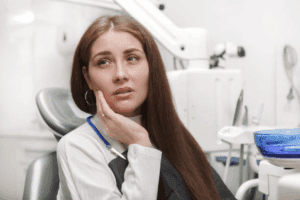
Why Post-Orthodontic Care Matters
Orthodontic treatment doesn’t end the moment your braces or aligners come off it simply enters a new phase. This stage is about protecting the results you worked so hard to achieve. Without proper post-treatment care, your teeth can shift, your bite can change, and your overall oral health can suffer. Taking the right steps now ensures your smile stays bright, straight, and healthy for years to come.
The risk of teeth shifting after treatment
Completing orthodontic treatment is a huge achievement, but the journey to your perfect smile doesn’t end when your braces or aligners come off. Without proper aftercare, teeth can gradually shift back to their original positions. This phenomenon, known as relapse, occurs because your teeth and surrounding ligaments need time to stabilize in their new alignment. Ignoring post-treatment care can undo months or even years of hard work.
Protecting your investment in orthodontics
Orthodontic treatment is not only a time commitment but also a significant financial investment. Following your orthodontist’s aftercare recommendations helps ensure that your results last for many years. Wearing retainers as instructed, attending follow-up visits, and maintaining oral hygiene are essential for safeguarding both your smile and your investment.
Long-term oral health benefits
Post-orthodontic care goes beyond aesthetics. Proper maintenance supports healthy gums, prevents tooth decay, and keeps your bite functioning correctly. Straight teeth are easier to clean, reducing your risk of gum disease and cavities. With the right care, you’ll enjoy a smile that’s both beautiful and healthy for decades.
Understanding Retainers and Their Role
Retainers are the unsung heroes of orthodontics. They may be small, but their role is enormous keeping your teeth in their new positions while your mouth adjusts. Without them, all the progress made during treatment can quickly reverse. Understanding how retainers work and the types available will help you choose and use yours effectively.
How retainers keep teeth in place
After orthodontic treatment, retainers hold your teeth in their newly aligned positions while the surrounding bone and ligaments adapt. This stabilization period is crucial because your teeth are most likely to shift immediately after braces or aligners are removed.
Different retainer types (fixed vs. removable)
There are two main types of retainers: fixed and removable. Fixed retainers are thin wires bonded to the back of your teeth, providing continuous support. Removable retainers, such as Hawley or clear plastic types, can be taken out for eating and cleaning. Each type has its pros and cons, and your orthodontist will recommend the one best suited to your needs.
Choosing the right retainer for your needs
Your choice of retainer depends on your treatment goals, lifestyle, and personal preferences. Some patients prefer the low-maintenance nature of fixed retainers, while others like the flexibility of removable ones. Discussing your daily habits and oral health needs with your orthodontist will help determine the most effective option for you.
Retainer Usage Tips for Lasting Results
Even the best retainer won’t work if it’s not worn correctly. How you care for and use your retainer directly impacts your long-term results. Following your orthodontist’s instructions, avoiding common mistakes, and keeping your retainer clean will help your smile stay exactly where it should be.
How often to wear your retainer
Initially, you’ll likely need to wear your retainer full-time, removing it only for eating, brushing, and flossing. Over time, your orthodontist may recommend switching to nighttime wear. Consistency is key skipping days can allow your teeth to move.
Cleaning and caring for your retainer
Regular cleaning prevents bacteria buildup and unpleasant odors. Removable retainers should be rinsed after each use and cleaned daily with a soft toothbrush and mild soap. Avoid hot water, which can warp the plastic. For fixed retainers, thorough brushing and flossing are essential.
Common mistakes to avoid
Avoid leaving your retainer in napkins, as it can be accidentally thrown away. Never expose it to extreme heat, and don’t skip cleaning. Most importantly, don’t assume you can stop wearing it without professional advice this is one of the quickest ways to lose your results.
Oral Hygiene After Braces or Aligners
Once your braces or aligners come off, you may feel a sense of freedom but oral hygiene should remain a top priority. Straight teeth are easier to clean, but they still need consistent care. Developing a routine with the right tools and avoiding harmful habits will protect your smile and your investment.
Brushing and flossing techniques
With your orthodontic appliances removed, it’s easier to brush and floss effectively. Use a soft-bristled toothbrush and fluoride toothpaste, brushing for two minutes twice a day. Floss daily using floss threaders or interdental brushes to reach between teeth.
Recommended dental tools post-treatment
Electric toothbrushes, water flossers, and interdental brushes can make cleaning more thorough and efficient. These tools help remove plaque from hard-to-reach areas, reducing the risk of decay and gum disease.
Foods and habits to avoid for smile protection
Avoid sticky candies, hard nuts, and foods that can chip or damage your teeth. Limit sugary drinks and acidic foods to protect enamel. Habits like nail-biting or chewing ice can also compromise your smile.
Preventing Teeth from Shifting
Relapse is one of the most common concerns after orthodontic treatment, but it’s also one of the most preventable. By staying vigilant, wearing your retainer consistently, and knowing the early warning signs, you can keep your smile aligned for years.
The importance of consistent retainer use
Your retainer is your best defense against shifting teeth. Wearing it as instructed ensures that your teeth remain in their correct positions long-term. Even small lapses can cause movement.
Recognizing early signs of movement
If your bite feels different or your retainer fits tighter than usual, these may be early signs of shifting teeth. Addressing these changes promptly can prevent further movement.
When to contact your orthodontist
If you notice discomfort, visible changes in tooth alignment, or damage to your retainer, contact Hamilton Dental Group immediately. Quick action can often correct minor issues before they become major concerns.
The Role of Follow-Up Visits
Follow-up appointments are an essential part of post-treatment care. They allow your orthodontist to monitor your progress, make small adjustments, and address issues before they become significant. Skipping these visits can jeopardize your results.
How often to schedule check-ups
After treatment, follow-up visits may be scheduled every few months initially, then annually. These appointments help ensure your teeth remain in their ideal positions.
What to expect during follow-up appointments
Your orthodontist will check your bite, evaluate tooth alignment, and ensure your retainer is functioning properly. They may also clean and adjust your retainer if needed.
Adjustments and minor corrections
Occasionally, small shifts may require minor corrections. Addressing these promptly prevents the need for more extensive treatment later.
Lifestyle Habits for a Healthy Smile
Maintaining a straight smile is not just about retainers it’s also about overall oral health. Your diet, hydration, and daily habits play a huge role in keeping your teeth and gums in great condition. Small lifestyle changes can have lasting benefits.
Diet choices that support oral health
Incorporate calcium-rich foods, crunchy vegetables, and vitamin-rich fruits into your diet. These promote strong teeth and healthy gums.
Staying hydrated for gum and enamel health
Water helps rinse away food particles and bacteria, keeping your mouth clean and your gums healthy. It also prevents dry mouth, which can increase the risk of decay.
Avoiding teeth grinding and bad habits
Bruxism (teeth grinding) can wear down enamel and alter tooth alignment. If you grind your teeth, talk to your dentist about a custom night guard.
Conclusion
Maintaining your smile after orthodontic treatment requires commitment, consistency, and regular professional care. Wearing your retainer as instructed, practicing excellent oral hygiene, and attending follow-up visits will protect your investment and keep your teeth healthy and beautiful. Your orthodontist’s guidance is your best resource for preserving your results trust their recommendations for lifelong benefits.
For personalized post-treatment care, schedule an appointment with Hamilton Dental Group today to keep your smile beautiful for years to come. Contact us or visit our office to get started.
FAQs – Post-Orthodontic Care
This section addresses the most common concerns patients have after completing orthodontic treatment. Knowing the answers to these questions will help you make informed decisions and avoid common pitfalls.
1: How long will I need to wear my retainer?
Most patients wear a retainer full-time for several months, then at night indefinitely. The exact timeline depends on your orthodontist’s recommendations.
2: Can I stop wearing my retainer after a year?
It’s not advisable without professional guidance. Teeth can shift even years after treatment.
3: What should I do if my retainer feels tight?
This could be a sign of shifting teeth. Wear it consistently and contact your orthodontist as soon as possible.
4: How can I tell if my teeth are shifting?
Look for changes in your bite, gaps forming, or your retainer fitting differently. Early detection is key.
5: Are follow-up visits really necessary?
Yes, they help catch minor issues before they become serious and ensure your smile stays in perfect condition.



